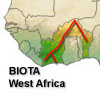 



Weather data
A large number of automatic weather stations has been implemented in the frame of the BIOTA AFRICA project by the Namibian National Botanical Research Institute (NBRI) and the Group "Biodiversity, Evolution and Ecology" (BEE) of the University of Hamburg. The website offers hourly updates of data and graphs of a large number of weather parameters.

|
 BIOTA West Africa - Workpackage - CT2-T2-WP2
BIOTA West Africa - Workpackage - CT2-T2-WP2
Core Topic (CT) |
Land use changes: agriculture and restoration |
Topic (T) |
Sustainable use of selected organisms |
Title |
 Complex consequences of unsustainable use of freshwater systems - amphibians
Complex consequences of unsustainable use of freshwater systems - amphibians
|
Project leader(s) |
Prof. Dr. Mark-Oliver Rödel
Prof. Dr. Adjima Thiombiano
|
Project description |
Tadpoles are key-organisms in maintaining water quality due to their enormous filter-feeding capacity. This is especially important in temporary waters where tadpoles often occur in high densities. Their role in regulating ponds’ nutrient cycles e.g. by grazing on blooming algae is well known. In addition carnivorous tadpoles feed substantially on arthropods and their larvae, including mosquito larvae. Thus they potentially function in controlling important vectors of human diseases (e.g. Anopheles flies that transmit different Plasmodium species).
Hence, the effects of the unsustainable use of frogs (e.g. for human consumption) are likely to be severe in tropical regions, such as in Western Africa. In temporary savanna waters tadpoles may reach enormous densities. In the same habitats many mosquitos with aquatic larvae (e.g. Anopheles and Aëdes) transmit severe diseases for humans and cattle (e.g. malaria, yellow fever, dengue fever, nagana). In this workpackage we aim to investigate for the first time the direct effects of the reduction or loss of particular tadpole species in tropical pond ecosystems by comparing natural with altered systems and by following an experimental approach with artificially combined pond communities. This will allow us to test for both the effect on water quality (characterized by the occurrence and abundance of particular algae and diatom species) and the presence and abundance of mosquito larvae. Based on this data we aim to develop a strategy for a sustainable use to reconcile the need of potable water for cattle (and humans), the use of a valuable protein source (frogs), and the preservation of diverse and stable amphibian communities. This especially concerns recommendations which species could be captured when and in which quantities, without severely altering the respective pond systems.
|
|
|






 Go to the WeatherNet
Go to the WeatherNet BIOTA West Africa - Workpackage - CT2-T2-WP2
BIOTA West Africa - Workpackage - CT2-T2-WP2 Complex consequences of unsustainable use of freshwater systems - amphibians
Complex consequences of unsustainable use of freshwater systems - amphibians